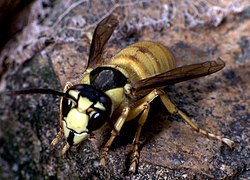| Black shield wasp | |
|---|---|
 | |
| Scientific classification | |
| Kingdom: | Animalia |
| Phylum: | Arthropoda |
| Class: | Insecta |
| Order: | Hymenoptera |
| Family: | Vespidae |
| Genus: | Vespa |
| Species: | V. bicolor |
| Binomial name | |
| Vespa bicolor Fabricius, 1787 | |
Vespa bicolor, the black shield wasp, described by Johan Christian Fabricius in 1787, is a species of hornet which has been found to be the pollinator of an orchid, [1] Dendrobium sinense (syn. Dendrobium christyanum ), found only on the Chinese island of Hainan. Vespa bicolor also preys on honey bees, which it feeds to its larvae. The orchid produces a chemical that mimics a honey bee pheromone and attracts this predatory wasp.
Vespa bicolor is the most common species of large wasp in Hong Kong, along with members of the genus Parapolybia . It is found in a wide range of environments and can be found near human dwellings.